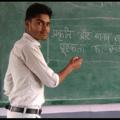Question 1 :
A pair of linear equations which has no solution, is called an __________________ pair of linear equations.
Question 2 :
Is the pair of equations x + 2y – 3 = 0 and 6y + 3x – 9 = 0 consistent?
Question 3 :
Given the linear equation 2x + 3y – 8 = 0, write another linear equation in two variables such that the geometrical representation of the pair so formed are parallel lines.
Question 4 :
The sum of a two-digit number and the number obtained by reversing the digits is 66. If the digits of the number differ by 2, find the number.
Question 5 :
Solve, by substitution : $x + 2y – 4 =0 , 2x + 4y – 12 =0$
Question 6 :
The taxi charges in a city consist of a fixed charge together with the charge for the distance covered. For a distance of 10 km, the charge paid is Rs. 105 and for a journey of 15 km, the charge paid is Rs. 155. How much does a person have to pay for travelling a distance of 25 km?
Question 7 :
Let a pair of linear equations in two variables be $a_{1}x+b_{1}y+c_{1}=0$ and $a_{2}x+b_{2}y+c_{2}=0$. If $\frac{a_1}{a_2}\ne\frac{b_1}{b_2}$, then the pair of linear equations is _______.
Question 8 :
In case of infinitely many solutions, the pair of linear equations is said to be __________.
Question 9 :
Solve the following pair of equations by reducing them to a pair of linear equations : $\frac{10}{x+y} + \frac{2}{x-y} = 4 ; \frac{15}{x+y} - \frac{5}{x-y} = -2$.
Question 10 :
Solve the following pair of equations by reducing them to a pair of linear equations : $\frac{1}{2x} + \frac{1}{3y} = 2 ; \frac{1}{3x} + \frac{1}{2y} = \frac{13}{6}$.
Question 11 :
<img style='object-fit:contain' src='https://teachmint.storage.googleapis.com/question_assets/cbse_ncert/61b19bdc273b230584979a2f.png' />
In the above fig, the lines represents ____________ lines.
Question 12 :
Solve the following pair of equations by reducing them to a pair of linear equations : $\frac{2}{\sqrt{x}} + \frac{3}{\sqrt{y}} = 2 ; \frac{4}{\sqrt{x}} - \frac{9}{\sqrt{y}} = -1$.
Question 13 :
The cost of 2 pencils and 3 erasers is Rs. 9 and the cost of 4 pencils and 6 erasers is Rs. 18. Find the cost of each pencil and each eraser.
Question 14 :
Roohi travels 300 km to her home partly by train and partly by bus. She takes 4 hours if she travels 60 km by train and the remaining by bus. If she travels 100 km by train and the remaining by bus, she takes 10 minutes longer. Find the speed of the train and the bus separately.
Question 15 :
Solve the following pair of equations by reducing them to a pair of linear equations : $\frac{5}{x-1} + \frac{1}{y-2} = 2 ; \frac{6}{x-1} - \frac{3}{y-2} = 1$.
Question 17 :
For what values of k will the following pair of linear equations have infinitely many solutions? $kx + 3y – (k – 3) =0 ; 12x + ky – k =0$
Question 18 :
Find out whether the lines representing a pair of linear equations are consistent or inconsistent: $2x + y – 6 = 0 , 4x – 2y – 4 = 0$
Question 19 :
Solve the following pair of linear equations: 21x + 47y = 110 and 47x + 21y = 162.
Question 20 :
Solve the following pair of linear equations by the elimination method and the substitution method : $3x – 5y – 4 = 0 ~and ~9x = 2y + 7$
Question 21 :
If we add 1 to the numerator and subtract 1 from the denominator, a fraction reduces to 1. It becomes $\frac{1}{2}$ if we only add 1 to the denominator. What is the fraction?
Question 22 :
A boat goes 30 km upstream and 44 km downstream in 10 hours. In 13 hours, it can go 40 km upstream and 55 km down-stream. Determine the speed of the stream and that of the boat in still water.
Question 23 :
The ratio of incomes of two persons is 9 : 7 and the ratio of their expenditures is 4 : 3. If each of them manages to save Rs. 2000 per month, find their monthly incomes.
Question 25 :
Solve the following pair of linear equations by the substitution method : $\frac{3x}{2} - \frac{5y}{3} = -2 ; \frac{x}{3} + \frac{y}{2} = \frac{13}{6}$
Question 26 :
Solve the following pair of equations by substitution method: $s-7t+42=0 ; s-3t=6$
Question 27 :
For which values of p and q, will the following pair of linear equations have infinitely many solutions? 4x + 5y = 2 and $\left(2p+7q\right)x+\left(p+8q\right)y=2q-p+1$.
Question 28 :
A fraction becomes $\frac{1}{3}$ when 1 is subtracted from the numerator and it becomes $\frac{1}{4}$ when 8 is added to its denominator. Find the fraction.
Question 29 :
On comparing the ratios $\frac{a_1}{a_2]$, $\frac{b_1}{b_2}$ and $\frac{c_1}{c_2}$, find out whether the lines representing a pair of linear equations are consistent or inconsistent: $2x – 3y = 8 ; 4x – 6y = 9$
Question 30 :
What is/ are the algebraic method/ methods that can solve a pair of linear equations?



























